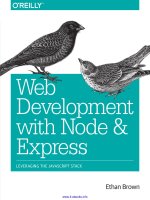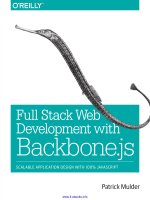ASP NET core 2 and angular 5 full stack web development with NET core and angular
Bạn đang xem bản rút gọn của tài liệu. Xem và tải ngay bản đầy đủ của tài liệu tại đây (33.33 MB, 542 trang )
ASP.NET Core 2 and Angular 5
Full-stack web development with .NET Core and Angular
Valerio De Sanctis
BIRMINGHAM - MUMBAI
ASP.NET Core 2 and Angular 5
Copyright © 2017 Packt Publishing
All rights reserved. No part of this book may be reproduced, stored in a retrieval system, or
transmitted in any form or by any means, without the prior written permission of the
publisher, except in the case of brief quotations embedded in critical articles or reviews.
Every effort has been made in the preparation of this book to ensure the accuracy of the
information presented. However, the information contained in this book is sold without
warranty, either express or implied. Neither the author, nor Packt Publishing, and its
dealers and distributors will be held liable for any damages caused or alleged to be caused
directly or indirectly by this book.
Packt Publishing has endeavored to provide trademark information about all of the
companies and products mentioned in this book by the appropriate use of capitals.
However, Packt Publishing cannot guarantee the accuracy of this information.
First published: November 2017
Production reference: 1221117
Published by Packt Publishing Ltd.
Livery Place
35 Livery Street
Birmingham
B3 2PB, UK.
ISBN 978-1-78829-360-0
www.packtpub.com
Credits
Author
Valerio De Sanctis
Copy Editor
Shaila Kusanale
Reviewers
Ramchandra Vellanki
Juergen Gutsch
Project Coordinator
Devanshi Doshi
Commissioning Editor
Ashwin Nair
Proofreader
Safis Editing
Acquisition Editor
Reshma Raman
Indexer
Rekha Nair
Content Development Editor
Onkar Wani
Graphics
Jason Monteiro
Technical Editor
Akhil Nair
Production Coordinator
Aparna Bhagat
About the Author
Valerio De Sanctis is a skilled IT professional with over 12 years of experience in lead
programming, web-based development, and project management using ASP.NET, PHP,
and Java. He previously held senior positions at a range of financial and insurance
companies, most recently serving as Chief Technology Officer and Chief Operating Officer
at a leading after-sales and IT service provider for many top-tier life and non-life insurance
groups.
In the course of his career, Valerio De Sanctis helped many private organizations to
implement and maintain .NET-based solutions, working side-by-side with many IT
industry experts and leading several frontend, backend, and UX development teams. He
designed the architecture and actively oversaw the development of a wide number of
corporate-level web application projects for high-profile clients, customers, and partners,
including London Stock Exchange Group, Zurich Insurance Group, Allianz, Generali,
Harmonie Mutuelle, AIG, QBE, Marsh & McLennan, Lloyd's, Honda Motor, FCA Group,
Luxottica, ANSA, Saipem, ENI, Enel, Terna, Banzai Media, Virgilio.it, Repubblica.it, and
Corriere.it.
He is an active member of the Stack Exchange Network, providing advice and tips for .NET,
JavaScript, HTML5, and other web-related topics on the StackOverflow, ServerFault, and
SuperUser communities. Most of his projects and code samples are available under open
source licenses on GitHub, BitBucket, NPM, CocoaPods, JQuery Plugin Registry, and
WordPress Plugin Repository.
Starting from 2015, he also runs an IT-oriented, web-focused blog at www.ryadel.com
featuring news, reviews, code samples and guides to help developers and enthusiasts
worldwide. Between 2016 and 2017, he wrote two books on web development: ASP.NET
Core and Angular 2, and ASP.NET Core: Cloud-ready, Enterprise Web Application Development,
with over 5,000 copies sold worldwide.
I would like to thank those who supported me in writing this book: my beloved and
beautiful wife, Carla, for her awesome encouragement and invaluable support; my
children, Viola and Daniele; my parents and my sister for always being there in times of
need; and my IT friends, colleagues, and partners working at Ryadel.com, Kapusons,
Teleborsa and Assirecre Group for their enduring friendship. A special thanks to Onkar,
Reshma, and all Packt Publishing folks who worked hard to bring this book to life. Last but
not least, I would like to thank you, the reader, for picking up this book. I really hope you
will enjoy it!
About the Reviewers
Ramchandra Vellanki is a passionate programmer. He has 13 years of programming
experience, has worked in different roles, and has experience in building and maintaining
large-scale products/applications. He started his career with IBM iSeries, and then worked
on C++, MFC, .NET, and JavaScript. Currently, he is working on .NET and JavaScript
technologies. He enjoys exploring and learning new technologies.
I would like to thank my parents (Saroja and Ramaiah), wife (Sirisha) and kids (Abhi and
Ani) for their love, understanding, and constant support. I also would like to thank all my
friends and relatives for their continuous encouragement and support throughout my
career and life.
Juergen Gutsch is a .NET-addicted web developer. He has been working with .NET and
ASP.NET since the early versions in 2002. Before that, he wrote server-side web applications
using classic ASP. Juergen is also an active person in the German speaking .NET developer
community. He is leading the .NET user group in Basel (Switzerland) and the INETA
Germany Association. Due to that, Microsoft awarded him to be a Microsoft Most Valuable
Professional in the Visual Studio and Development Technologies category several times.
Jurgen writes for the dotnetpro magazine, one of the most popular German-speaking
developer magazines, and he also publishes articles in English on his blog at https://asp.
net-hacker.rocks. The best way to contact him and to stay in touch with him is using
Twitter--https://twitter.com/sharpcms.
He is working as a developer, consultant, and trainer for the digital agency
YooApplications Inc. (http://yooapps.com), located in Basel, Switzerland. YooApplications
serves national as well as international clients and specializes in creating custom digital
solution for distinct business needs.
www.PacktPub.com
For support files and downloads related to your book, please visit www.PacktPub.com. Did
you know that Packt offers eBook versions of every book published, with PDF and ePub
files available? You can upgrade to the eBook version at www.PacktPub.com and as a print
book customer, you are entitled to a discount on the eBook copy. Get in touch with us at
for more details.
At www.PacktPub.com, you can also read a collection of free technical articles, sign up for a
range of free newsletters and receive exclusive discounts and offers on Packt books and
eBooks.
https://www.packtpub.com/mapt
Get the most in-demand software skills with Mapt. Mapt gives you full access to all Packt
books and video courses, as well as industry-leading tools to help you plan your personal
development and advance your career.
Why subscribe?
Fully searchable across every book published by Packt
Copy and paste, print, and bookmark content
On demand and accessible via a web browser
Customer Feedback
Thanks for purchasing this Packt book. At Packt, quality is at the heart of our editorial
process. To help us improve, please leave us an honest review on this book's Amazon page
at />If you'd like to join our team of regular reviewers, you can e-mail us at
We award our regular reviewers with free eBooks and
videos in exchange for their valuable feedback. Help us be relentless in improving our
products!
Table of Contents
Preface
Chapter 1: Getting Ready
Two players, one goal
The ASP.NET core revolution
What's new in Angular?
A full-stack approach
Single-Page Application
Common features of a competitive SPA
Product Owner expectations
A sample Single-Page Application project
The vision
Not your usual "Hello World!"
Introducing TestMakerFree
Core features and requirements
Preparing the workspace
Disclaimer-Do (not) try this at home
The broken code myth
Stay hungry, stay foolish, yet be responsible as well
Versions and builds
Setting up the project
Alternative setup using the command line
Test run
Looking around
The configuration files
Program.cs
Startup.cs
The appsettings.json file
The package.json file
Upgrading (or downgrading) Angular
Upgrading (or downgrading) the other packages
The tsconfig.json file
The webpack configuration files
Updating the webpack.config.js file
Patching the webpack.config.vendor.js file
Why use a dynamic module bundler?
Refreshing the Webpack-generated files
The server-side code
Controllers/HomeController.cs
1
9
10
10
11
12
13
13
15
17
17
18
18
19
21
21
21
23
23
24
28
29
30
32
32
34
38
39
40
41
43
45
47
48
49
49
50
50
Table of Contents
Controllers/SampleDataController.cs
The /Views/ folder
The client-side code
The /ClientApp/app/ folder
Getting to work
Static file caching
A blast from the past
Back to the future
Testing it up
The strongly-typed approach(es)
Client app cleanup
Trimming down the component list
The AppModule class(es)
Updating the NavMenu
References
Suggested topics
Summary
51
52
53
54
56
56
57
58
61
62
63
63
66
67
68
69
69
Chapter 2: Backend with .NET Core
70
The data flow
The role of ViewModel
Our first ViewModel
QuizViewModel
QuizController
71
74
74
75
76
78
79
79
80
81
81
82
84
85
86
87
89
89
89
91
92
93
95
96
Adding more action methods
ByTitle()
Random()
Testing it up
Adding other controllers
QuestionViewModel
QuestionController
AnswerViewModel
AnswerController
ResultViewModel
ResultController
Understanding routes
Defining routing
Routing through the ages
Handling routes in .NET Core
Three choices to route them all
Adding more routes
The Dummy Data Provider
Dealing with single entries
[ ii ]
Table of Contents
Suggested topics
Summary
100
100
Chapter 3: Frontend with Angular
101
Navigation pattern
Master/detail binding
The Quiz client-side interface
The QuizList component
The new Angular HttpClient
A match against the old standard
How to install it
How to use it
Dependency Injection
Get and subscribe
The onSelect() method
The template file
The Stylesheet file
Adding the component
The AppModule file(s)
The HomeComponent template
Testing it up
The QuizComponent class
Adding the Component files
Adding the component
Testing it up
Adding additional lists
Multiple components instances
Testing and debugging
The OnInit interface and lifecycle hooks
Implementing ngOnInit
Testing it up
Two-way data binding
Disabling two-way data binding
Client-side routing
PathLocationStrategy versus HashLocationStrategy
Refactoring our app
Registering a new Route
Upgrading the QuizComponent
Getting the ID parameter
Adding the HttpClient
Fetching the data
Updating the QuizListComponent
Master/Detail Routing test
Adding new components
AboutComponent
[ iii ]
102
103
104
105
107
107
108
109
109
109
110
110
112
112
112
114
114
115
115
117
118
119
120
123
125
126
129
129
131
132
133
133
135
136
136
138
139
140
141
142
142
Table of Contents
LoginComponent
PageNotFoundComponent
Updating the AppModule
143
143
144
146
150
150
Full-Scale test
Suggested topics
Summary
Chapter 4: Data Model with Entity Framework Core
Getting ready
Installing Entity Framework Core
Data Modeling approaches
Model-First
Database-First
Code-First
Pros
Cons
Taking a choice
Creating Entities
ApplicationUser
Quiz
Question
Answer
Result
Defining relationships
The one-to-many EF Lazy-Load pattern
Setting up the DbContext
Database initialization strategies
Choosing the Database Engine
Updating the appsettings.json file
Creating the Database
Updating Startup.cs
Adding the Initial Migration
The "No executable found matching command dotnet-ef" error
Understanding Migrations
Implementing a Data Seed strategy
Creating a DbSeeder class
Adding the DbSeeder to Startup.cs
Seeding the Database
Updating the QuizController
Introducing Mapster
Installation
Basic usage
[ iv ]
151
152
152
155
155
157
158
159
159
159
159
160
162
164
165
167
168
170
171
173
174
175
175
176
176
178
179
180
180
187
189
190
190
190
191
Table of Contents
Updating the QuizController
192
195
196
196
Testing the Data Provider
Suggested topics
Summary
Chapter 5: Client-Server Interactions
Add, update, and delete quizzes
Updating QuizController
Adapting the client
Adding QuizEditComponent
Activating the Edit mode
Event handlers versus router links
Adding the Edit route
Implementing the Delete feature
A word on Observables
First client-server test
The client-server workflow
Questions, answers, and results
Server-side tasks
QuestionController
AnswerController
ResultController
BaseApiController
Implementing BaseApiController
Client-side tasks
Adding the interfaces
QuestionListComponent
Introducing ngOnChanges()
Why bother?
The template file
Adding the references
QuestionEditComponent
References and routes
AnswerListComponent
AnswerEditComponent
The template file
References and routes
ResultListComponent
Reference and routes
ResultEditComponent
Full-scale test
Suggested topics
Summary
Chapter 6: Style Sheets and UI Layout
[v]
198
198
199
203
203
208
209
209
210
211
211
215
217
217
217
222
226
231
232
233
234
234
237
239
239
240
241
244
244
247
248
249
249
250
252
253
259
260
261
Table of Contents
How bad is it, doc?
Introducing LESS
Style sheet languages
CSS
CSS code sample
What is LESS and why use it?
Variables
Import directives
Nested selectors
Mixins
Extend pseudo-class
LESS docs and support
SASS, Stylus, and other alternatives
Implementing LESS
Installing LESS compiler
Compiling LESS files with Webpack
DIY versus framework-based styling
Do-it-yourself approach
Pros
Cons
Framework-based approach
Pros
Cons
Conclusions
Working with Bootstrap
Changing the theme
Rebuild the Webpack vendor config file
Delete the /wwwroot/dist/ folder
Update the .csproj file
Create the update-webpack.bat file
Testing the new theme
Revising the UI structure
AppComponent
NavMenuComponent
QuizSearchComponent
Registering QuizSearchComponent
The logo SVG file
A quick test
Styling the components
CSS encapsulation
Native encapsulation using Shadow DOM
Disable encapsulation
HomeComponent
QuizListComponent
[ vi ]
261
262
262
263
263
264
266
266
267
268
270
271
271
272
273
275
276
277
277
277
278
278
278
279
279
280
281
281
282
282
284
284
284
286
288
290
290
291
292
292
294
296
296
297
Table of Contents
Another UI test
QuizComponent
Testing it up
QuizEditComponent
Question, answer, and result components
Buttons and icons
Tables and DIVs
Forms and inputs
Full-scale layout test
Suggested topics
Summary
Chapter 7: Forms and Data Validation
Data validation
Forms in Angular
302
305
309
310
312
313
314
315
316
317
317
319
320
320
321
322
322
323
326
326
327
331
334
335
335
337
340
343
343
344
345
345
349
350
351
351
352
Template-Driven forms
The pros
The cons
Model-Driven/Reactive forms
Our first Reactive form
Adding ReactiveFormsModule
Updating QuizEditComponent
Adding validators
Adding shortcuts
Upgrading components
QuestionEditComponent
AnswerEditComponent
ResultEditComponent
Debugging and testing
A look at the Form Model
The pipe operator
Reacting to changes
Observing the Observable
Extending the activity log
Client-side debugging
Forms unit testing
Suggested topics
Summary
Chapter 8: Authentication and Authorization
To auth, or not to auth
Authentication
353
354
354
355
355
356
Third-party authentication
The rise and fall of OpenID
OpenID Connect
[ vii ]
Table of Contents
Authorization
Third-party authorization
Proprietary versus third-party
Proprietary auth with .NET Core
Setting up the .NET Core Identity
Configuring the Identity service
Extending the ApplicationUser
Upgrading the DbContext
Revising the DbSeeder
A word on async tasks, awaits, and deadlocks
Updating the database
Adding the identity migration
Applying the migration
Option #1 - update
Option #2 - drop and recreate
Seeding the data
Authentication methods
Sessions
Tokens
Signatures
Two-factor
Conclusions
Implementing JWT authentication
Add the auth service to the .NET Core Startup class
Updating the AppSettings files
The TokenController
Upgrading the BaseApiController
Reflecting the upgrade on the affected controllers
Adding the TokenController
The TokenRequestViewModel
The TokenResponseViewModel
Testing with Postman
Angular login form
The TokenResponse interface
The AuthService class
Updating the AppModule
The new LoginComponent
First login test
Adding the token to the HTTP request header
The AuthInterceptor class
Adding the HttpInterceptor in the AppModule
Enforcing authorization
Adapting the client
[ viii ]
357
357
358
360
360
360
362
363
363
369
370
370
371
372
372
373
374
374
376
378
378
378
379
380
382
383
383
385
385
389
389
390
392
393
393
397
398
403
407
407
408
410
411
Table of Contents
NavMenuComponent
QuizComponent
Client-server auth test
Suggested topics
Summary
411
413
414
415
416
417
418
Chapter 9: Advanced Topics
419
Shielding the server
Retrieving the current user ID
Token expiration and refresh tokens
What's a refresh token?
Server-side tasks
Adding the token entity
Upgrading the user entity
Upgrading ApplicationDbContext
Applying the EF core migration
Implementing the refresh token
Upgrading TokenResponseViewModel
Upgrading TokenRequestViewModel
Upgrading TokenController
Client-side tasks
Updating the TokenResponse interface
Upgrading AuthService
Adding AuthResponseInterceptor
Add the AuthResponseInterceptor in the AppModule
Testing it up
New user registration
Server-side tasks
UserController
UserViewModel
Client-side tasks
The user interface
RegisterComponent
Custom validator
Template and style sheet files
AppModule
LoginComponent
NavMenu
Testing it up
Third-party authentication
OAuth2 authorization flow
Implicit flow versus explicit flow
Implicit flow pros and cons
Explicit flow pros and cons
Conclusions
[ ix ]
419
420
421
421
422
423
424
424
424
424
425
429
430
430
432
435
435
436
436
436
438
439
439
440
442
443
443
444
444
445
447
447
448
449
450
450
Table of Contents
Logging in with Facebook
Creating the Facebook app
Implicit flow
Updating TokenController
Adding the GenerateRandomPassword() method
Adding LoginFacebookComponent
Understanding zones
Adding the template file
Updating AppModule
Linking LoginFacebookComponent
Testing it up
Explicit flow
Installing the Authentication.Facebook package
Setting up the Facebook Authentication service
Updating the appsettings.json file
Upgrading TokenController
The ExternalLogin method
Adding SignInManager
The ExternalLoginCallback method
The LoginExternalProvider component
Updating AppModule
Linking LoginFacebookComponent
Testing it up
Suggested topics
Summary
Chapter 10: Finalization and Deployment
Switching to SQL Server
Installing SQL Server 2017 Express
Installing SQL Server Management Studio
Configuring the database
Changing the authentication mode
Adding the TestMakerFree database
Adding the TestMakerFree login
Mapping the login to the database
Adding a SQL Server connection string
Working with the Connection Strings
Adding production URL to External Providers
Updating the launchSettings.json file
Publishing our native web application
Creating a Publish profile
FTP Publish Profile
Folder Publish Profile
Publishing our web app
Configuring the web server and IIS
[x]
450
451
454
455
458
460
464
465
466
466
467
467
468
468
469
470
470
471
472
476
479
479
480
480
480
482
482
483
484
485
486
486
486
487
489
489
490
491
492
492
494
495
496
497
Table of Contents
Installing the ASP.NET Core module for IIS
Adding the website
Configuring the Application Pool
Firing up the engine
Troubleshooting
Browser output message
The Web.Config file
Event Viewer
ASP.NET Core Module logging
The Kestrel test
Kestrel Test from Visual Studio
Disable server-side rendering
Suggested topics
Summary
Index
497
498
500
501
503
503
505
508
508
509
510
511
511
512
513
[ xi ]
Preface
It's only been a year since I wrote ASP.NET Core and Angular 2, but it definitely feels a lot
more, at least from a web developer's perspective. Modern web technologies are still
improving at lightning-fast speed, with an increasing, perceptible, and measurable interest
being in the client-side aspects of the game. Angular, React, and VueJS collected no less
than 150,000 StackOverflow questions in the latest 18 months, which is more than 250 per
day--and the trend is still growing.
That's to be expected, since most of the major conceptual changes that occurred between
2015 and 2017 have been hitting the clients way more than the servers; we switched from a
reactive approach of doing stuff--that led us to build responsive, resilient, elastic, and
message-driven Single-Page Apps (SPAs)--to a progressive way of seeing things--which
materialized into Progressive Web Apps (PWAs). The change of perspective is slight, yet
prominent; far from being a different paradigm, what we've seen was nothing less than the
natural and inevitable evolution of the same original concepts.
Compared to the SPA revolution that took place in 2015-2016, the rise of Progressive Web
Apps is not a game-breaking event; we can say that PWAs inherit all the major concepts that
were already part of the Reactive Manifesto and bring them further on with brand new
features--such as Service Workers--that would not have been possible without some
relevant client-side accomplishments such as HTML5, modern browsers, and ECMAScript
6. PWAs are a much expected improvement in the present that also emphasizes its
increasing distance from the past. At the same time, PWAs are not meant to be the future,
not because they won't become a standard--they definitely will--but because they will also
improve and, eventually, collapse into something else. This is how the client side of the moon
always worked and--hopefully--always will.
Preface
What happened to the other side, then? We can't possibly say that 2017 wasn't an intense
year for server-side technologies; Node.js is still dominating the scene, with more than 8
million confirmed instances online at the moment and trustable surveys telling us that three
developers out of four will deal with it even more than they did. As well as the raw and
naked usage, there is also a crowded galaxy of modern web frameworks based on Node,
boosting its popularity even more, such as Hapi, Express, Restify, Koa, Sails, and Adonis,
just to mention some of them. Django continues to focus on stability, with the 1.11 LTS
bringing a lot of minor and major fixes; the next major release, expected for December, will
also bring some neat improvements such as simplified URL routing syntax, window
expressions, and improved Phyton 3.x support. The whole PHP ecosystem, which seemed
to be slowly but steadily doomed to lose ground, regained some breath thanks to the great
performance achievements reached by PHP 7.1 (in late 2016) and the huge number of
available frameworks--Symfony, Laravel, Zend, Yii, Expressive, Silex, Slim, and more--each
of which is best suited for a distinctive set of patterns, use cases, and scenarios. Last but
definitely not least, comes ASP.NET; the .NET Core 2.0 release features some major
improvements that make it easier to use and also more capable as a platform: major
performance boosts in both framework and runtime, six new supported platforms-including Debian, SUSE, and macOS--and even ARM32-native builds for running apps on
Raspberry Pi.
If we try to connect all these dots, we can easily see how most of the innovative,
experimental, and rule-changing aspects of web development are nowadays skewed
toward the client side, while the server-side race is more focused on performance and
stability. Nonetheless, both sides of the coin share a strong common ground built upon the
concepts of readability, maintainability, and overall simplicity of the source code.
Back in 2016, among all those different and yet kindred environments, we chose to focus on
two of them: ASP.NET Core to cover the server-side aspects, and Angular to deal with the
client side. Apart from the technical reasons, we also did this because these two frameworks
had something in common that we did like: both of them were a reboot of a massively
popular previous installment that played a leading role in their respective field. That was a
bold, revolutionary move that we liked a lot. Should we do the same in 2017 as well? Are
ASP.NET Core 2 and Angular 5 still a viable choices to deal with Progressive Web Apps,
lightning-speed performance, and code simplicity?
In short, the answer is yes, and the book you're about to read will do its very best to prove
it.
[2]
Preface
What this book covers
Chapter 1, Getting Ready, introduces the ASP.NET Core and Angular frameworks,
explaining how they can effectively be used to build a feature-rich, modern web
application. It then enumerates the core aspects of a common SPA project, which will be
addressed throughout the following chapters. The last part covers the required steps for
setting up a .NET Core web application project, along with its required packages and
components, up to a buildable and running app skeleton.
Chapter 2, Backend with .NET Core, explains how we can build our very own set of APIs to
exchange JSON data between a server-side ASP.NET Core Controller and a client-side
Angular Component. The reader will learn how to handle the HTTP request-response cycle
and also how to configure the improved routing logic built upon the .NET Core pipeline.
Chapter 3, Frontend with Angular, focuses on the client-side aspects; the reader will learn
how to fetch JSON objects with Angular and show the retrieved data onscreen using the
Angular Template Syntax. They will also understand how to deal with client-side routing in
Angular and how to implement a viable routing pattern using the PathLocationStrategy
approach.
Chapter 4, Data Model with Entity Framework Core, guides the reader through implementing
a proper, DBMS-based Data Model using Entity Framework (EF) Core. They will learn how
to install and properly configure the required EF Core packages, then use them to build a
lightweight set of entities and persist them into a database structure using the Code-First
approach.
Chapter 5, Client-Server Interactions, shows how the existing code can be upgraded to make
full use of the EF Core Entities defined in the last chapter. The reader will learn how to fetch
and persist the application data using the database instead of the sample objects mocked by
the previous data-retrieval methods.
Chapter 6, Style Sheets and UI Layout, introduces LESS, a powerful dynamic style sheet
language that can be compiled into CSS. After a brief overview of the LESS language
syntax, the reader will learn how to add, implement, and compile LESS scripts within the
application project to greatly improve the frontend UI.
Chapter 7, Forms and Data Validation, is mostly dedicated to passing data from the client to
the server, from account-related features--such as user registration--to more complex
interactions with the whole range of existing Entities. The reader will learn how to send
PUT- and POST-based requests using the versatile Angular Model-Driven approach, and how
to properly respond to them by extending the existing .NET Core Controllers accordingly.
[3]
Preface
Chapter 8, Authentication and Authorization, starts as a recap of the most relevant auth-
related concepts for building a web application and then shows how to turn these concepts
into practice. The reader will learn how to implement a sample token-based auth provider
and also how to properly add and configure it throughout the existing Entity Framework
entities, .NET core services, and HTTP middleware list.
Chapter 9, Advanced Topics, shows how to implement a specific set of features required to
finalize a production-ready web application, such as token expiration, refresh tokens, new
user registration, and third-party authentication.
Chapter 10, Finalization and Deployment, describes the most common tasks to publish a
potentially shippable web application onto a production server. The reader will learn how
to replace the localDb instance with an external SQL Server, create FTP and FileSystem
publishing profiles, upload their compiled application to an external server, and configure
it to run under IIS using the .NET Core Windows Server Hosting bundle; they will also
learn how to deal with the most common issues with the help of some .NET Core-specific
troubleshooting techniques.
What you need for this book
Windows 7 SP1 or newer, up to and including Windows 10
Visual Studio 2017 15.4.2 (or newer): any version will work, including the freely
available Community Edition
Microsoft SQL Server 2017 (o newer) for Chapter 10, Finalization and Deployment
only: any version will work, including the freely available Express Edition
Windows Server 2008 R2 (or newer) for Chapter 10, Finalization and Deployment
only
Microsoft .NET Core SDK 2.0.1, freely available as an official Microsoft download
TypeScript 2.1.5.0 (or newer), freely available
NodeJS 6.11.2 (or newer), freely available
Angular 5.0.0 final release (or newer), freely available
All ASP.NET, Angular, JavaScript, and CSS packages used throughout the book are also
open source and freely available for download using Visual Studio package managers such
as NuGet and npm.
[4]
Preface
Who this book is for
This book is for seasoned ASP.NET developers who already know about ASP.NET Core
and Angular in general, but want to know more about them and/or understand how to
blend them together to craft a production-ready SPA.
Conventions
In this book, you will find a number of text styles that distinguish between different kinds
of information. Here are some examples of these styles and an explanation of their meaning.
Code words in text, database table names, folder names, filenames, file extensions,
pathnames, dummy URLs, user input, and Twitter handles are shown as follows:
"Fill it with its corresponding pagenotfound.component.html template file."
A block of code is set as follows:
import { Component } from "@angular/core";
@Component({
selector: "pagenotfound",
templateUrl: "./pagenotfound.component.html"
})
export class PageNotFoundComponent {
title = "Page not Found";
}
When we wish to draw your attention to a particular part of a code block, the relevant lines
or items are set in bold:
Welcome to TestMakerFree
A sample SPA project made with .NET Core and Angular.
<quiz-list class="latest"></quiz-list>
<quiz-list class="byTitle"></quiz-list>
<quiz-list class="random"></quiz-list>
Any command-line input or output is written as follows:
dotnet ef database update
[5]
Preface
New terms and important words are shown in bold. Words that you see on the screen, for
example, in menus or dialog boxes, appear in the text like this:
"Open a PowerShell Command Prompt and navigate through the project's root folder."
Warnings or important notes appear like this.
Tips and tricks appear like this.
Reader feedback
Feedback from our readers is always welcome. Let us know what you think about this
book-what you liked or disliked. Reader feedback is important for us as it helps us develop
titles that you will really get the most out of. To send us general feedback, simply email
, and mention the book's title in the subject of your message. If
there is a topic that you have expertise in and you are interested in either writing or
contributing to a book, see our author guide at www.packtpub.com/authors.
Customer support
Now that you are the proud owner of a Packt book, we have a number of things to help you
to get the most from your purchase.
Downloading the example code
You can download the example code files for this book from your account at http://www.
packtpub.com. If you purchased this book elsewhere, you can visit http://www.packtpub.
com/support and register to have the files emailed directly to you. You can download the
code files by following these steps:
1. Log in or register to our website using your email address and password.
2. Hover the mouse pointer on the SUPPORT tab at the top.
3. Click on Code Downloads & Errata.
[6]









